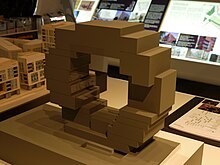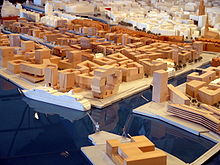Science Center Hamburg
The Science Center Hamburg or Science Center is an unrealized design by the architect Rem Koolhaas in the HafenCity in Hamburg . In addition to the building itself, the term describes one of the originally planned central uses, a kind of scientific adventure museum .
HafenCity Hamburg GmbH , which is responsible for the development and marketing of HafenCity, named the Science Center as one of the three central cultural institutions of HafenCity alongside the Elbphilharmonie and the International Maritime Museum Hamburg .
At the beginning of 2008, construction work was still expected to start in the second half of 2009 and completion by 2011.
At the end of 2014 it was finally announced that as part of the takeover of the overall development and realization of the southern Überseequartier by the real estate company Unibail-Rodamco , an approximately 70 m high office building is now planned in place of the Science Center. The building, designed by the architect Christian de Portzamparc, is to have a public viewing platform and represent a special city closure in the axis between the existing city and the Elbe.
draft
The design comes from the Dutch architect Rem Koolhaas and Koolhaas' Office for Metropolitan Architecture (OMA) and envisaged a building in the form of a ring made of individual, cubic modules on its side. The building was to be built in Überseequartier , the central part of HafenCity, directly on the western bank of Magdeburg Harbor .
The Science Center was already included in the overall urban planning concept of the Überseequartier from 2005. The first draft already had the idea of a central, openwork, disk-like structure, but its shape was similar to a tub tilted on its side. This first version also corresponded with the original design for the cruise terminal in the southwestern part of Überseequartier, which essentially corresponded to that of the Science Center, but was not placed on its side, but lying on its side. In January 2008, Koolhaas and the OMA presented the revised design for the building, for which the idea of the open center was further developed and made much more prominent.
The building was by then planning a height of 70 meters and a gross floor area of 23,000 sqm GFA have. In contrast, the first draft provided for a gross floor area of only 14,000 m².
use
The main use of the building was to house a scientific adventure exhibition. The exhibition should contain 10 subject areas that should appeal to children and young people in particular through appropriate media processing and presentation and interaction with the exhibits . The concept was comparable to the Universum Bremen or the phæno in Wolfsburg . A large aquarium attached to the exhibition was planned for a long time, but this was ultimately abandoned in view of the existing tropical aquarium in Hagenbeck's zoo and the structurally difficult integration into the typologically demanding building. In the first draft of the Science Center, a planetarium was also considered as a possible use, which was also no longer included in the later planning.
In addition to the exhibition use, a number of other uses were to be accommodated in the building in order to support the financing of the overall project.
financing
No public information was available on the project's expected investment costs. The HafenCity Hamburg GmbH explained that the project largely on the involvement of third party users and the use of private sponsors had instructed. However, the company assumed that there was great public interest in the project and accordingly expected substantial donations from sponsors to cover part of the costs. Part of the financing was also to be borne by the Überseequartier project development consortium, and the City of Hamburg made EUR 46 million available for the project as part of a special investment program. After the cost explosion in the construction of the Elbphilharmonie, however, politicians did not want to take responsibility for another major cultural project in Hafencity.
After the original investors in Überseequartier got into difficulties in the course of the financial crisis in 2008 , a new major investor had to be found and the original development plan had to be completely revised in 2014. The Science Center fell victim to the new plans because of its lack of profitability.
gallery
Individual evidence
- ↑ HafenCity Hamburg GmbH (ed.): "Curtain up: HafenCity as a stage for culture". In: HafenCity Projects No. 12, p. 35. Self-published, Hamburg 2009.
- ^ Citizenship of the Free and Hanseatic City of Hamburg (ed.): Printed matter 19/1735
- ↑ HafenCity Hamburg GmbH (ed.): "Curtain up: HafenCity as a stage for art, culture and events". In: Projects. Insights into current developments No. 9, p. 31. Self-published, Hamburg 2008.
- ↑ http://www.hamburg.de/pressearchiv-fhh/4421086/hafencity/
- ^ HafenCity Hamburg GmbH (Ed.): "Überseequartier - The heart of HafenCity". In: Projects. Insights into current developments No. 5, p. 17. Self-published, Hamburg 2006.
- ^ Citizenship of the Free and Hanseatic City of Hamburg (ed.): Printed matter 19/1735
- ^ HafenCity Hamburg GmbH (Ed.): "Überseequartier - The heart of HafenCity". In: Projects. Insights into current developments No. 5, p. 17. Self-published, Hamburg 2006.
- ↑ HafenCity Hamburg GmbH (ed.): "Curtain up: HafenCity as a stage for art and culture". In: Projects. Insights into current developments No. 10, p. 31. Self-published, Hamburg 2008.
- ↑ http://www.taz.de/!5026262/
- ↑ http://www.abendblatt.de/hamburg/article135327717/Mega-Projekt-Die-HafenCity-naehert-sich-ihrer-Vollendung.html





